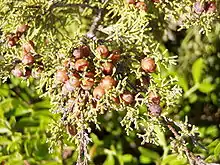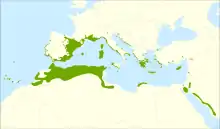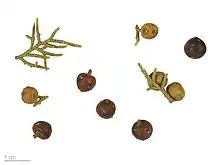Juniperus phoenicea
Juniperus phoenicea, the Phoenicean juniper or Arâr,[3] is a juniper found throughout the Mediterranean region, from Morocco and Portugal east to Italy, Turkey and Egypt, south on the mountains of Lebanon, the Palestine region and in western Saudi Arabia near the Red Sea, and also on Madeira and the Canary Islands. It mostly grows at low altitudes close to the coast, but reaches 2,400 metres (7,900 ft) altitude in the south of its range in the Atlas Mountains. It is the vegetable symbol of the island of El Hierro.[4]
| Juniperus phoenicea | |
|---|---|
 | |
| Scientific classification | |
| Kingdom: | Plantae |
| Clade: | Tracheophytes |
| Division: | Pinophyta |
| Class: | Pinopsida |
| Order: | Pinales |
| Family: | Cupressaceae |
| Genus: | Juniperus |
| Section: | Juniperus sect. Sabina |
| Species: | J. phoenicea |
| Binomial name | |
| Juniperus phoenicea | |
 | |
| Natural range | |
| Synonyms[2] | |
| |

Description
Juniperus phoenicea is a large shrub or small tree reaching 5–8 metres (16–26 ft) tall, with a trunk up to 1–2 metres (3 ft 3 in–6 ft 7 in) in diameter and a rounded or irregular crown. The bark, which can be peeled in strips, is dark greyish-brown. The leaves are of two forms, juvenile needle-like leaves 5–14 mm long and 1 mm wide on seedlings, and adult scale-leaves 1–2 mm long on older plants with a green to blue-green color; they are arranged in opposite decussate pairs or whorls of three. It is largely monoecious, but some individual plants are dioecious. The female cones are berry-like, 6–14 mm in diameter, orange-brown, occasionally with a pinkish waxy bloom, and contain 3-8 seeds; they are mature in about 18 months, and are mainly dispersed by birds. The male cones are 2–4 mm long, and shed their pollen in early spring, which is wind-pollinated.
Infraspecific taxa
There are two varieties, treated as subspecies by some authors and as separate species by others:[5]
- Juniperus phoenicea var. phoenicea = J. phoenicea. Throughout the range of the species. Cones globose, about as wide as long. Leaves are small and obtuse. Sheds pollen in the spring.
- Juniperus phoenicea var. turbinata (syn. Juniperus turbinata). Confined to coastal sand dune habitats. Cones oval, narrower than long. Leaves are long and thin. Sheds pollen in the autumn.
Ecology
This species prefers a hot, arid climate with a lot of light, and grows on rocky or sandy ground. Its preferred soil is calcareous with a pH between 7.7-7.9 (moderately basic), but could also be silicate. Despite having a shallow root system,[6] it can survive with as little as 200 mm of rain per year. It can often be found forming scrubs and thickets with other species. [7] In its natural range of France and Spain, J. phoenicea has a generational life of 25 years, and is considered a stable species on the 2016 IUCN Red List of Threatened Species.[8]
Its habitat in coastal areas is most threatened by the presence of humans, both settled and touring. Humans also plant not-naturally-present plants such as pines, black locust, French tamarisk, desert false Indigo, American agave, tree of heaven, and some succulent plants from South Africa. The purpose of this is usually to stabilize the dunes, but these outside plants interfere with the natural vegetation. It is also threatened easily by fires, because it is quite flammable and does not regenerate well. This makes it necessary to plant new organisms after a fire has damaged the others.[9]
Uses

Juniper berries are used as a seasoning in cooking or in alcoholic beverages, particularly to flavor gin.[10] Juniper berries have also been used in traditional medicine for different conditions, although there is no high-quality clinical evidence that it has any effect.[10] Although extracts of juniper berries or wood tar have been used as an aroma – particularly for cosmetics – the safety of using ointments manufactured from J. phoenicea and related species has not been adequately demonstrated, according to a 2001 review.[11] Juniper extracts used topically may cause skin allergic reactions, and should be avoided during pregnancy.[10]
The tree's essential oil is especially rich in the tricyclic sesquiterpene thujopsene.[12] The heartwood contains an estimated 2.2% of thujopsene. The biochemist Jarl Runeburg noted in 1960 that Juniperus phoenicea appears to be the most convenient source of thujopsene so far encountered."[6] Juniper wood is used for small manufactured objects and inlay works in carpentry, and in building construction in Africa where it is mainly used for fuel and producing charcoal.[7]
References
- Allen, D.J. (2017). "Juniperus phoenicea". IUCN Red List of Threatened Species. 2017: e.T16348983A99965052. doi:10.2305/IUCN.UK.2017-2.RLTS.T16348983A99965052.en.
- The Plant List: A Working List of All Plant Species, retrieved 11 February 2017
- ambiguous Arabic name also given to Tetraclinis articulata
- Ley 7/1991, de 30 de abril, de símbolos de la naturaleza para las Islas Canarias
- "Juniperus turbinata". World Checklist of Selected Plant Families. Royal Botanic Gardens, Kew. Retrieved 2018-01-28.
- Runeberg, Jarl; Gramstad, Thor; Larsson, Lennart; Dodson, R. M. (1960). "The Chemistry of the Natural Order Cupressales. XXXI. Heartwood Constituents of Juniperus phoenicea L." Acta Chemica Scandinavica. 14: 1995–8. doi:10.3891/acta.chem.scand.14-1995.
- González, A. Gastón; García-Viñas, J. I.; Saura, S.; Caudullo, G.; de Rigo, D. (2016). "Juniperus thurifera in Europe: distribution, habitat, usage and threats" (PDF). European Atlas of Forest Tree Species. European Commission.
- Allen DJ (29 July 2016). "Phoenician juniper". IUCN Red List of Threatened Species. 29 July 2016. doi:10.2305/IUCN.UK.2017-2.RLTS.T16348983A99965052.en.
- Kabiel, Hanan F.; Hegazy, Ahmad K.; Lovett-Doust, Lesley; Al-Rowaily, Saud L.; Al Borki, Abd El-Nasser S. (2016). "Ecological assessment of populations of Juniperus phoenicea L. In the Al-Akhdar mountainous landscape of Libya". Arid Land Research and Management. 30 (3): 269–89. doi:10.1080/15324982.2015.1090499.
- "Juniper". Drugs.com. 2018. Retrieved 22 February 2019.
- "Final report on the safety assessment of Juniperus communis extract, Juniperus oxycedrus extract, Juniperus oxycedrus tar, Juniperus phoenicea extract, and Juniperus virginiana extract". International Journal of Toxicology. 20 Suppl 2 (2): 41–56. 2001. doi:10.1080/10915810160233758. ISSN 1091-5818. PMID 11558640.
- "Pubchem Compound Database; CID 442402: Thujopsene". Pubchem, National Center for Biotechnology Information, US National Library of Medicine. 16 February 2019. Retrieved 22 February 2019.
General references – links
| Wikimedia Commons has media related to Juniperus phoenicea. |
- Conifer Specialist Group (1998). "Juniperus phoenicea". IUCN Red List of Threatened Species. 1998. Retrieved 28 July 2006.CS1 maint: ref=harv (link)
- Adams, R. P. Junipers of the World: The genus Juniperus. Victoria: Trafford, 2004. ISBN 1-4120-4250-X
- Gymnosperm Database: Juniperus phoenicea
- Zsolt Debreczy; Istvan Racz (2012). Kathy Musial (ed.). Conifers Around the World (1st ed.). DendroPress. p. 1089. ISBN 978-9632190617.
